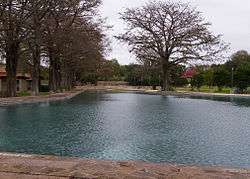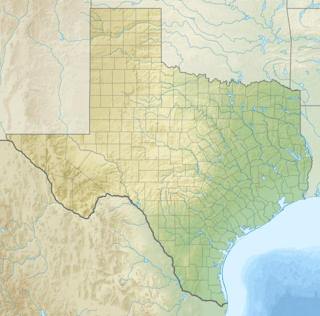San Pedro Springs Park
|
San Pedro Springs Park | |
 San Pedro Springs Park | |
 San Pedro Springs Park  San Pedro Springs Park | |
| Location |
1415 San Pedro Avenue San Antonio, Texas |
|---|---|
| Coordinates | 29°26′49″N 98°30′06″W / 29.44694°N 98.50167°WCoordinates: 29°26′49″N 98°30′06″W / 29.44694°N 98.50167°W |
| NRHP Reference # | 79002916[1] |
| RTHL # | 3806 |
| Significant dates | |
| Added to NRHP | November 1, 1979 |
| Designated RTHL | 1965 |
San Pedro Springs Park is located in the Bexar County city of San Antonio in the U.S. state of Texas. Surrounding the source of the springs, the 46-acre park is the oldest in the state of Texas. It is the location of a Payaya Indian village known as Yanaguana,[2] and is the original site of the city of San Antonio.[2] The park is alternately known as San Pedro Park. The park was designated a Recorded Texas Historic Landmark in 1965.[3] It was added to the National Register of Historic Places listings in Bexar County, Texas on November 1, 1979.[2] It is the second oldest city park in the United States after Boston Common.
History, first European contact, founding of San Antonio
Archaeological findings have uncovered evidence that human presence in the area dates back 12,000 years.[4] The earliest recorded inhabitants of the springs were the Payaya Indians, who referred to their village as Yanaguana .[2] Spanish Franciscian priest Damián Massanet led the first European contact with the area, a military expedition in 1691.[5] In 1709, Spanish Franciscan missionary Isidro de Espinosa and a retinue of Spanish soldiers traveled to the area. In his diary, Espinoza described the springs in detail and noted they had named it Agua de San Pedro (Waters of Saint Peter).[4] Martín de Alarcón founded the city of San Antonio by establishing San Antonio de Valero and Presidio San Antonio de Bexar at the Springs in 1718.[2] He built an acequia (irrigation canal) in 1719. The springs and surrounding area were designated as public land by King Philip V of Spain in 1729.[4][6] When the Canary Islanders began arriving in 1731, they first camped in this area.[2]
The park
Based on the original Spanish land grant, the city of San Antonio's first surveyor Francois P. Giraud defined the park's boundaries in 1851.[7] The city officially declared it a public park in 1852, making it the oldest park in the state of Texas.[4] By 1856, the U.S. Camel Corps had camel stables on the site.[8] In 1860, Sam Houston stopped here to deliver a two-hour speech opposing the proposed Texas secession from the United States.[6] During the Civil War the park was used as a prisoner of war camp. After the Civil War, Buffalo Soldiers used the park as a training camp.[4]
Swiss landscape designer John J. Duerler leased land adjacent to the park, and reached an 1864 agreement with the city to redesign the park. Duerler developed the park with landscaping, a garden, picnic areas, a zoo and aviary, a music pavilion, and even a racetrack.[9] Naturalist Gustave Jermy opened the Museum of Natural History in the park in 1885. The park suffered in 1891 when wells dug into the Edwards Aquifer dwindled the park's water supply. Between 1897 and 1899, the park was renovated under the direction of Mayor Bryan Callaghan. Beginning just before World War II, the water needs of a burgeoning population once again decreased water levels, drying up the springs for the next 35 years. When excessive rainfalls during the 1990s replenished the park's water supply, the public once again became interested in the park.[6][8] The park underwent an additional renovation 1998-2000.[10]
Park facilities include a gazebo, swimming pool, restrooms, softball and tennis areas, a playground, a skate plaza, the San Pedro Library, and the San Pedro Playhouse [11]
Gallery
 1907 Postcard, San Pedro Springs Park and Lake
1907 Postcard, San Pedro Springs Park and Lake
See also
References
- ↑ National Park Service (2008-04-15). "National Register Information System". National Register of Historic Places. National Park Service.
- 1 2 3 4 5 6 "NRHP-THC San Pedro Springs Park". Texas Historical Commission. Retrieved September 28, 2012.
- ↑ "RTHL-THC San Pedro Park". Texas Historical Commission. Retrieved September 28, 2012.
- 1 2 3 4 5 "The Oldest Park in Texas". Texas Highways. Retrieved September 28, 2012.
- ↑ Bremer, Thomas S (2003). "The Native Place of Yanaguana". Blessed with Tourists: The Borderlands of Religion and Tourism in San Antonio. The University of North Carolina Press. pp. 11–19. ISBN 978-0-8078-5580-5.
- 1 2 3 "San Pedro Springs". Edwards Aquifer. Retrieved September 28, 2012.
- ↑ Stover R.L.A., Scott E. "San Pedro Springs Park, Texas" (PDF). Design. U. S. Department of the Interior (Winter 1996): 6, 7. Retrieved November 2, 2012.
- 1 2 Permenter, Paris; Bigley, John (2008). Insiders' Guide to San Antonio, 4th. Insider's Guide. p. 188. ISBN 978-0-7627-4787-0.
- ↑ Aldrich, Melodye (2011). The Lerich Family: History and Remembrances. Authorhouse. p. 123. ISBN 978-1-4685-0552-8.
- ↑ Kendall, Dorothy Steinbomer. "San Pedto Park". Handbook of Texas Online. Texas State Historical Association. Retrieved September 28, 2012.
- ↑ "San Pedro Springs park". Parks and Recreation. City of San Antonio. Retrieved September 28, 2012.
External links
| Wikimedia Commons has media related to San Pedro Springs Park. |